-
Posts
1,739 -
Joined
-
Last visited
-
Days Won
53
Content Type
Profiles
Forums
Events
Posts posted by Syzygies
-
-
Using a Smoke Pot
For smoke, I have a two quart cast iron dutch oven, with three 1/8" holes drilled in the bottom. I fill it with apple and/or hickory chips and chunks; 40# bags from Lazzari last a long time, even two quarts at a time. I seal the lid with a flour/water paste, pretty much what Moroccans do to keep their couscous pots tight. I set the pot in with the charcoal. Typically, I use a propane torch to light the charcoal under the pot.
This is modeled after the procedure for making charcoal; the wood off-gases and turns to charcoal without ever actually burning. I only use this for low & slow; somewhere near 300 F the pot gases catch fire, and can generate an extraordinary amount of heat. (After a small starter fire, making charcoal is self-sustaining.)
In other words, I'm only using part of the smoke I could be using. This is a selection process, and selection processes change taste. Armagnac tastes different from moonshine, in part because of a different selection process while distilling.
Our smoke becomes one ingredient of many, in balance with the other seasonings, even using two quarts of smoking wood at a time. My wife won't let me do this any other way, after tasting the difference.
After many cruel disappointments at commercial establishments serving BBQ with no smoke, one can become obsessed with smoke. It is unlikely that all of one's guests will share this distorted obsession. One can also get over this, and realize that smoke is an ingredient, to use in balance.
-
If I name "them"??? I only ordered one!

You must have a couple of Webers, right? How about "Big Steve and the twins?"
-
It would be nice to arrange a "universal" hole, that could be adapted to either the BBQ Guru, the Stoker, or any brand yet to emerge. (Brands do also disappear.)
Were I to order a Stoker (and a KK with said breathing tube) I'd probably want to go back and forth to my dead-simple Pit Minder, depending on the cook.
The draft door adapters are unwieldy, unnecessarily big, and an unwanted intellectual challenge to insert properly. That's why I drilled a Guru port into my old K.
-
We ordered the shoulder, one day notice, from Diablo Foods: 3615 Mount Diablo Blvd, Lafayette, CA. Twenty minutes away for us, but the best butcher this side of the Berkeley/Oakland hills.
I'd be stunned if there isn't an outstanding butcher in Napa that can also order this. We have various family up there; I can ask...
-
Oh man, it melted in our mouths with tortillas from fresh masa.
I'm a veteran of many butts, but I'm never looking back. Clearly this thread tapped a well of expertise with the whole shoulder. My vote (skin down) is why look back, I'm buying shoulders from now on.
-

Looks better now!
-

Boy am I glad I checked this thread! I though about taking the skin off, but I'm thinking the meat by the skin will come out real moist. I started to put the shoulder on skin up, but after this discussion I raced back out to flip it over.
Picnic to the left? I've cooked plenty of butts over the years, and I don't recall anything looking like a leg stump.
(The cooker in question is a "Sacramento skinless" #7 Kamado, we're waiting for it to actually crack in half before we buy a Komodo Kamado.)
Thanks.
-

This is my first time with a whole pork shoulder (butt + picnic). The skin on may be a nice effect, keeping meat moister, we'll see. But does anyone understand the markings?
Is P for Pig?
-

SEATTLE--(BUSINESS WIRE)--Aug. 6, 2009-- Amazon.com, Inc. (NASDAQ:AMZN) today announced the release of its barbecue controller, “Kindling™,†which is now available on Amazon's home page.
Amazon was able to release this device so quickly because of similarities in function to its “Kindle™†line of e-book readers. An electronic paper display makes sense for barbecue, said Amazon founder Jeff Bezos, because pit temperatures don't change so quickly. Users can control their pits remotely over Amazon Whispernet using the Sprint EVDO network.
The kicker? For adjusting pit temperatures, the “Kindling™" sports a touch screen, like the e-book reader being developed by Amazon rival Plastic Logic.
"It's rather embarrassing" confesses Bezos. "The Kindle had a touch screen all along, but we originally planned to go with Verizon for wireless connectivity. Verizon likes to cripple functionality on anything they get near, you know, like what they do to Bluetooth on their cell phones? When we switched to Sprint, we just plain forgot to turn the touch screen back on. Doh!"
Asked if he worried about rival Plastic Logic entering the barbecue market, Bezos was dismissive, saying Plastic Logic already had their hands full. "Have you seen Barnes and Noble's pricing for e-books? Anyhow, Plastic Logic can't get text-to-voice to work on AT&T's network. The books all sound like someone talking over an iPhone."
-
Hi. Does anyone have a strong recommendation for a Foodsaver alternative?
Our top-of-the-line Foodsaver is getting a bit beat. There's masking tape jammed into the "is the lid closed?" sensor to trick it into working. For actual boil in pouch, I always make two seals, as one can give; other brands are like "dental tape -vs- dental floss" and make an 1/8" wide seal one might trust.
Requirements:
Able to process 20-30 bags in a row without overheating and stopping.
Able to handle liquids.
Single seal won't give when used boil-in-pouch.
("Channel" bags ok, they're 20 cents each if bought from anyone besides FoodSaver.)
Thanks,
Dave
-
Yep, you must do something. (Cheesecloth?) A fully cooked butt is enough of a challenge moving from the grill to the foil/towel cooler without falling apart.
-
The weather is strange everywhere! Here in Seattle' date=' we've had 28 straight days without any rain....[/quote']
... and in Northern California we've actually had rain, always overcast and 10 degrees below normal. Strange June, can't grow okra. Was there a meteor hit nearby I didn't hear about?
-
Closeout sale
So "we" misplaced our Thermapen, which was a cause for serious panic till it turned up. (Yes, they're worth it.) Exploring my options, I noticed a closeout sale, direct from the manufacturer:
Closeout PriceReduction! Order Now at Only $74 Each!
http://www.thermoworks.com/products/thermapen/tpen_home.html
-
I prefer my home-fermented hot sauce to anything I can buy, but I buy wine. They do it better.
I've roasted coffee at a beach house. Nice psychological effect. If the alternative was supermarket coffee, I'd roast my beans all the time. In a major market like the San Francisco area, there are people who can do a far better job.
This is coming from someone who grinds his own flour for everything. You can't sell whole wheat flour without removing the germ first, which goes bad in days. But they leave the bran in, so it handles like sand and tastes like a roll of unbleached paper towels fell in. We sieve out the bran (if you want bulk in your diet, eat greens) and with the germ included we get a chestnut-colored flour that handles like white flour, tastes far better.
This is to establish that I'm nuts enough to roast my own coffee. I respect anyone who does such things for themselves. But it may not be worth it...
-
Alcohol starts
I use the 'green goo' gelatinized alcohol for lo-n-slo starts.(available only at Barbecues Galore anymore it seems.)Huh. Didn't know there was such a thing. While I tend to use either mapp torch (very directed, starts fire under my smoke pot, to spread over 24 hours for low & slow) or chimney or electric starter, I've also been a big fan of alcohol starts.
One needs as close to 100% alcohol as available, not the 80% stuff. I pour it on, get ready to close the cooker, light with a torch, close and back off. The womp can cause birds to fly away in the neighborhood, like in the movies. All show, I've never been hurt.
A serious advantage is that unlike lighter fluid, this burns off completely with no aftertaste. It's all about where you are in molecular weight; petroleum byproducts are heavier, nastier molecules. Even parafin is a petroleum byproduct. It doesn't smell nearly as bad as lighter fluid, but it isn't my choice.
Alas, the disadvantage is that drugstore alcohol isn't ethanol. (One can buy large cans of denatured ethanol at hardware stores, but seldom as cheaply.)
Ethanol is the lightest alcohol molecule, it burns safefly into water and carbon dioxide. It also doesn't kill you when you drink it because as it breaks down, it has nowhere to go but safe.
The drugstore rubbing alcohols burn less safely, with carbon monoxide as a byproduct. In your body they can break down into some nasty byproducts, which is why you don't drink the stuff.
Nevertheless, this is fear-mongering. Charcoal itself produces plenty of carbon monoxide, which is why we don't use it indoors, and one can simply clear the area while the fire lights. (I hold my breath as I walk away, so I don't have a bad math day.) No one was planning to drink the stuff, and it wouldn't be legal for sale to rub all over if this had the same effect as drinking it.
Once the fire gets up to speed, the alcohol is gone. Period. End of story. A purist wanting an accelerant would light their fires with pure ethanol, and view any solution whatsoever involving heavier molecules as inferior.
-
If you want to save the drippings use a heat deflector under the pan' date=' add a bit of water in the pan.[/quote']
...and don't brine the meat! It's either/or, unless you think salt is the new sugar.
-
I line with heavy duty aluminum foil an unlined 16" terra cotta plant saucer from Home Depot. Heat deflector and drip pan in one. The foil always leaks a bit, giving the terra cotta some character. I'm on my second or third saucer, but they're inexpensive. Don't buy lined unless you're prepared to test the glaze yourself (same mistake as galvanized metal in a cooker).
-
I wouldn't go 750/800 F dome for tandoori chicken in a ceramic cooker, at least for any recipe I know. Every 50 F step above 550 F is pretty dramatic, I'd take them one at a time.
Temperature is only one element of the puzzle, and more is not always better; every cooker is different in its heat delivery characteristics. This is not a single variable (temperature) problem. For an example which is approximately two variables, take a pizza stone, where the temperature and the thermal transfer rate of the stone material work together to determine how the stone cooks. A ceramic cooker is a more complex system, closer to a tandoor than to a conventional oven, but not the same. I can't use the same pizza temperatures in my cooker that I saw Sicilians use in room-sized wood fired ovens, and I can't use the same tandoor temperatures that an Indian would use in an authentic tandoor. Nevertheless, if one makes an adjustment to one's cooker, the results can be delicious.
Here are some pictures of a tandoori chicken recipe that I like:
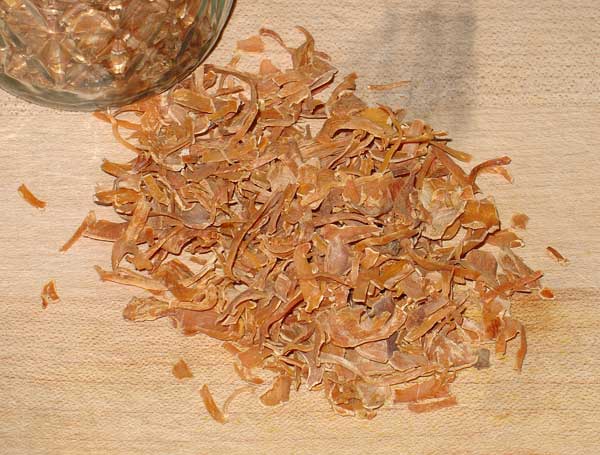
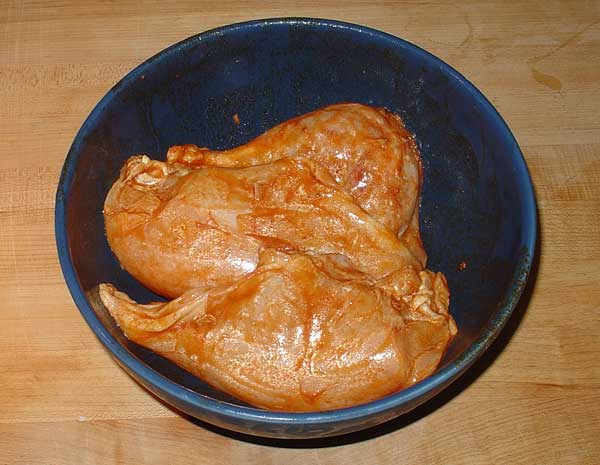
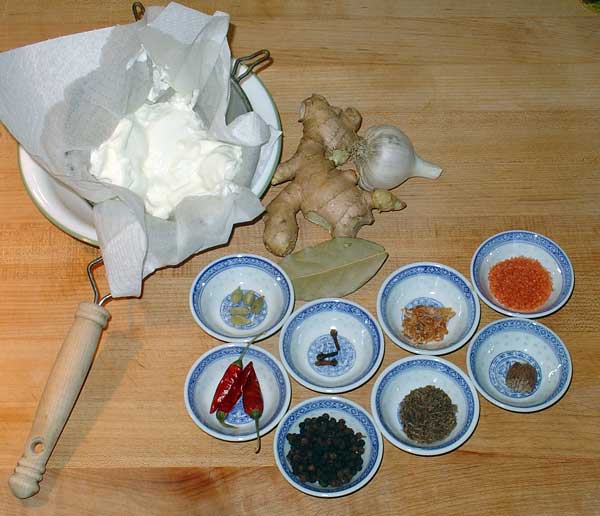
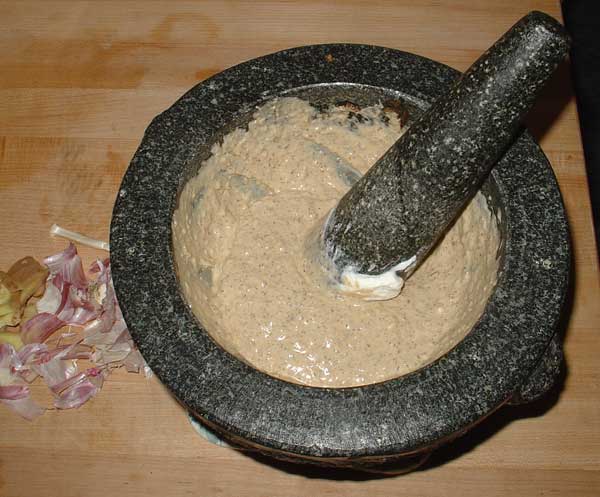
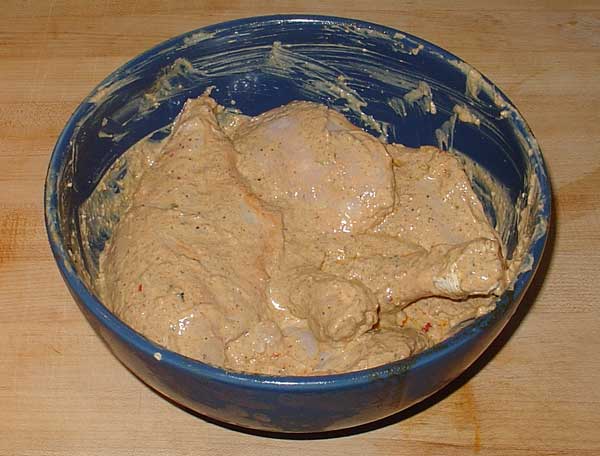
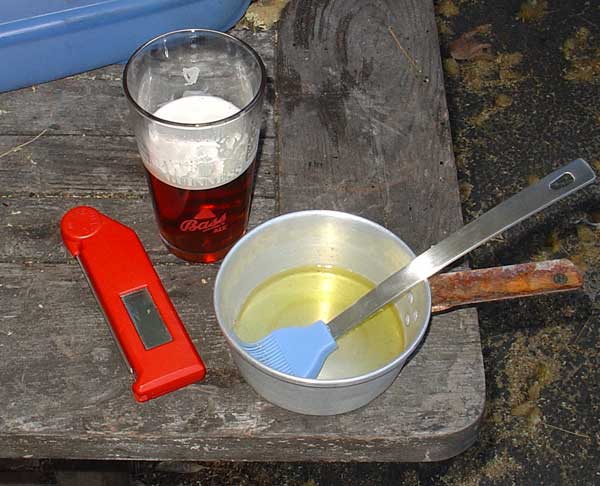

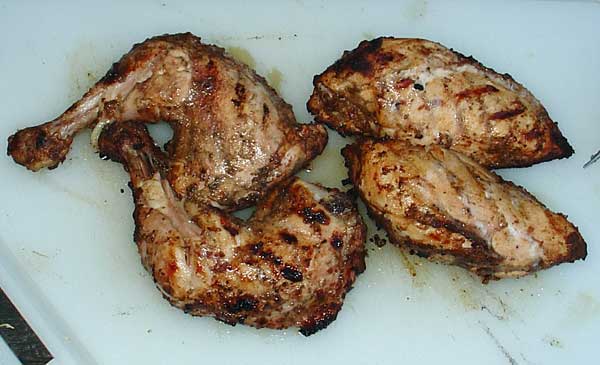
Here are some notes of mine from 2005, that I've edited a bit for this post:
"Tandoor" by Ranjit Rai (ISBN 1585671444; addall.com, overstock.com) is a definitive treatise on Indian Tandoor barbecue, written originally for publication in India. It is quite approachable, particularly if one has cooked other Indian dishes before. Nevertheless, he assumes that one is using ingredients as found in India, and actually cooking in a Tandoor. I find this refreshing; I'm comfortable making adaptations to my circumstances, but I cringe at the idea of others making adjustments for me, that may not be relevant to my circumstances. For example, a ceramic cooker is very much like a Tandoor; much could get lost in translation by starting with a recipe adapted to a conventional oven.
The following is my adaptation for a ceramic cooker of his "Tandoori Chicken"; I have tried to be as faithful as possible to his original intent, e.g. bringing into this recipe comments on technique made elsewhere in the book. There are many other recipes given for poultry, lamb, fish, vegetables, bread, accompaniments; I hope that this adaptation serves as an advertisement for the book, which belongs on any comprehensive barbecue bookshelf.
This chicken is the first dish I've made on my cooker that is both exciting enough for me, and exciting to Laurie's nine year old daughter, who has requested that we make it every night.
1 whole chicken, 3-4 lbs
2 TB vinegar
3 TB oil
1/2 TB ground chile or hot paprika
1 tsp salt
This is a typical size for a U.S. chicken, but roughly twice the size of the chicken specified in the recipe, so I give cooking times longer than the book. Nevertheless, quantities here yield plenty of marinade; I'd double everything for three chickens. One can follow the book's cooking times more closely for "tikka", or uniform chunks of meat.
Quarter and skin the chicken, and pierce various places with a knife. Trim the quarters of any extraneous extremities, setting the scraps aside to freeze with the wings and backbone for stock. Mix the marinade ingredients, toss the chicken quarters in the marinade, and chill for an hour or so.
Arrange the ingredients for the second marinade:
1 cup yogurt
1 tsp salt
2 TB ginger
2 TB garlic
1 bay leaf
3 cloves
4 green cardamom pods
1/4 tsp mace
1/4 tsp nutmeg
1 TB black peppercorns
1 tsp caraway seeds
3 red chiles
1 TB oil
Drain the yogurt through a paper towel and a strainer. In a large Thai mortar and pestle or equivalent machine, pound the ginger and garlic with the salt to a paste. Use only the black insides of the cardamom pods; seed the chiles. In a heavy frying pan, gently roast each of the dry spices until fragrant, grind in a spice grinder, and pound into the mortar paste. Mix in the oil and yogurt. Drain the original marinade from the chicken, coat with the new marinade, and chill for six hours or as long as practical.
("White" cardamom is simply a bleached version of the green, so stock one kind, green. If you can find mace in strands as shown in the picture, it is far superior to preground mace.)
4 to 8 TB ghee (or clarified butter)
Preheat the cooker to 600 F, and set up the upper grill for direct cooking. Have a mop and melted ghee at the ready for basting. Put on the quarters, adjust the cooker to 550 F or so, and turn and baste every 5 minutes. The chicken will be done in 20 to 30 minutes, a matter of taste, the actual cooking temperature, and the size of the bird.
As tempting as it is to apply this approach to spatchcocked (butterflied) chicken, at these temperatures either the legs or the breast can finish first. In my opinion the breasts are done when a Thermapen registers in the 140's to 150's F anywhere one probes, and the legs are done in the 150's to 160's. Some may regard these temperatures as undercooked, so cook instead to your liking. The quarters will continue to cook a bit after they come off.
-
 1
1
-
 1
1
-
-
This is all relative, because one learns to cook based on a given instrumentation strategy, as long as one is consistent. The debate whether to do a low & slow at 210 F or 225 F gets mixed up with this debate; no two people can accurately compare these numbers or their probe locations, but one person can learn through consistency how to obtain the barbecue that they like.
I reason that with the probe 2" from the meat, I'm measuring the boundary effect that directly determines how the meat will cook. If there are other lags in the system (there are!) then they're not distracting me, e.g. I'm not waiting for the dome temp to equalize with my grill measurement before I get "full traction" from the control process.
In other words, I don't see what advantage I gain from the grill temp around the meat starting out lower than a dome temp held steady by a guru. If I want a lower starting temp, I could just dial this in manually.
On the other hand, having made the decision that I'd rather regulate the temp 2" from the meat, I regulate it as a lower temperature than I would have selected for a dome temp.
To summarize, I want to control the temp where it matters most, then compensate for how this could be a different number than I'd choose for a different location.
-
I'm disappointed that they're discontinuing the Pit Minder E-temp.
I actually downsized to this, giving my fancier guru to a friend because I actively prefer the simplicity of twisting a dial, setting a temp, and that being the whole story.
I am not a Luddite. I've built many computers from scratch, and designed simple circuits such as a current mirror that can charge 8 AA cells from an iPod power supply, getting by with only 0.1 volts overhead. So I'm not afraid of complexity. I just think that complexity isn't needed in a pit controller; nothing beats a simple dial.
-
...you ought to be able to find something to gage that size against. Maybe Mrs Gerard could help you out?

FM, do you get arrested at airport security often? Or is this forum your safe haven outlet?
I found a source of 3 oz bottles for making up a "carry-on travel" size of this year's hot sauce batch. The bottles truly are 3 oz each, but they look for all the world like they hold a quart, I was worried mine would be misjudged and then seized by the TSA. All manner of rejoinders to the TSA supervisor as to why the first agent got it wrong ran through my head, some not unlike your comment above.
"No, Dave, you're an adult now. Just give up the hot sauce, get to your destination..."
No problems. I was upgraded, with a decent burger snack in first for the red-eye, and slathering it with hot sauce was a nice new treat.
-
As Lazzari has their warehouse not so far from me, I systematically use oak lump for hotter cooks, and KK extruded for low & slows.
For low & slows, I'd say that the KK extruded passes the final test for me. There's tremendous potential for wishful thinking here, but if there were any element of denial in my assessment, I'd be feeling an odd choke in my throat by now, each time I reach for the stuff. I spend a lot of time computer programming, and when I cook my one aim is to get the best food on the table for my friends, so my inner monologue is a slightly crazed rotation through all the views of what to check, what could go wrong, with everything reexamined and no sacred cows. If I were worried about the charcoal, I'd notice by now.
Instead, I exhibit an odd preference for the KK extruded over my remaining hoard of classic K extruded. I have no idea why, but it doesn't let me down. 24 hour cooks use only a fraction of the fuel I can load, so the ash issue has had no practical consequences for me.
If I had to guess, no coconut extruded is completely neutral, my KK hoard is fresher, and I am worried that my smoking wood is old enough to be past prime. (Lazzari sells huge bags, and I'm due.) So I'm reaching for the KK extruded to compensate. Whatever.
We had a freak 70 degree sunny day last saturday, a record for Concord, CA, and a dozen friends over for butt, pot beans, tortillas before I headed to icy New York for a new semester. What a contrast!
-
Somehow, watching that video, I kept thinking how our snake doesn't always eat both rat fuzzies that we buy her. That charcoal is scaled nicely for an appetizer alternative to driving back to the reptile store.
-
Chasing links, here's Glenn's full blown treatment:
http://www.kamado.com/discus/messages/3/33231.html?1162143829
(I'm the gumbo recipe he links to, "great article about stock". My off-brand ceramic cooker needs a repair, so tonight's chicken went into a chicken pot pie, lard crust from SF Farmers Market lard, home-ground flour. Made a double stock from stock and the new bird. The stock makes the dish.)



Stoker details
in Komodo General
Posted
Re: better solution
I also think he should build a wireless interface into the device. I wrote him to suggest this, didn't hear back. So these other stories don't surprise me.
On islands off of Sicily, they skipped the whole land-line phone thing, went straight to cellular. If my daughter's netbook can pick up every base station in the neighborhood, this can't be hard.
Meanwhile, BBQ Guru replaced their PitMinder with a no-display model, only two buttons. Can't help but think of the evolution of film cameras, where abruptly it became cheaper to go digital than to build mechanical controls. Then the film itself went digital. We can't be far off from the day where a wireless web browser interface to a BBQ controller will be less expensive than those two remaining buttons.